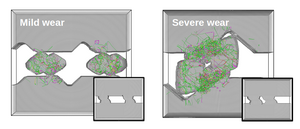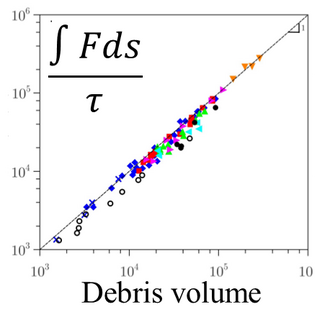
Aghababaei, R., Brink, T and Molinari, J-F (2018) Asperity-level origins of transition from mild to severe wear, Physical Review Letters, accepted.
Abstract: Wear is the inevitable damage process of surfaces during sliding contact. According to the well-known Archard's wear law, the wear volume scales with the real contact area and as a result is proportional to the load. Decades of wear experiments, however, show that this relation only holds up to a certain load limit, above which the linearity is broken and a transition from mild to severe wear occurs. We investigate the microscopic origins of this breakdown and the corresponding wear transition at the asperity level. Our atomistic simulations reveal that the interaction between subsurface stress fields of neighbouring contact spots promote the transition from mild to severe wear. The results show that this interaction triggers the deep propagation of subsurface cracks and the eventual formation of large debris particles, with a size corresponding to the apparent contact area of neighbouring contact spots. This observation explains the breakdown of the linear relation between the wear volume and the normal load in the severe wear regime. This new understanding highlights the critical importance of studying contact beyond the elastic limit and single-asperity models.

Aghababaei, R., Warner, D. H. and Molinari, J.-F. On the debris-level origins of adhesive wear, Proceedings of the National Academy of Sciences, 114 (30) 7935-7940, 2017.
Abstract: Every contacting surface inevitably experiences wear. Predicting the exact amount of material loss due to wear relies on empirical data and cannot be obtained from any physical model. Here, we analyze and quantify wear at the most fundamental level, i.e., wear debris particles. Our simulations show that the asperity junction size dictates the debris volume, revealing the origins of the long-standing hypothesized correlation between the wear volume and the real contact area. No correlation, however, is found between the debris volume and the normal applied force at the debris level. Alternatively, we show that the junction size controls the tangential force and sliding distance such that their product, i.e., the tangential work, is always proportional to the debris volume, with a proportionality constant of 1 over the junction shear strength. This study provides an estimation of the debris volume without any empirical factor, resulting in a wear coefficient of unity at the debris level. Discrepant microscopic and macroscopic wear observations and models are then contextualized on the basis of this understanding. This finding offers a way to characterize the wear volume in atomistic simulations and atomic force microscope wear experiments. It also provides a fundamental basis for predicting the wear coefficient for sliding rough contacts, given the statistics of junction clusters sizes.

Aghababaei, R., Warner, D. H. and Molinari, J.-F. (2016) Critical length scale controls adhesive wear mechanisms, Nature Communications, 7:11816, 2016.
Abstract: The adhesive wear process remains one of the least understood areas of mechanics. While it has long been established that adhesive wear is a direct result of contacting surface asperities, an agreed upon understanding of how contacting asperities lead to wear debris particle has remained elusive. This has restricted adhesive wear prediction to empirical models with limited transferability. Here we show that discrepant observations and predictions of two distinct adhesive wear mechanisms can be reconciled into a unified framework. Using atomistic simulations with model interatomic potentials, we reveal a transition in the asperity wear mechanism when contact junctions fall below a critical length scale. A simple analytic model is formulated to predict the transition in both the simulation results and experiments. This new understanding may help expand use of computer modelling to explore adhesive wear processes and to advance physics-based wear laws without empirical coefficients.